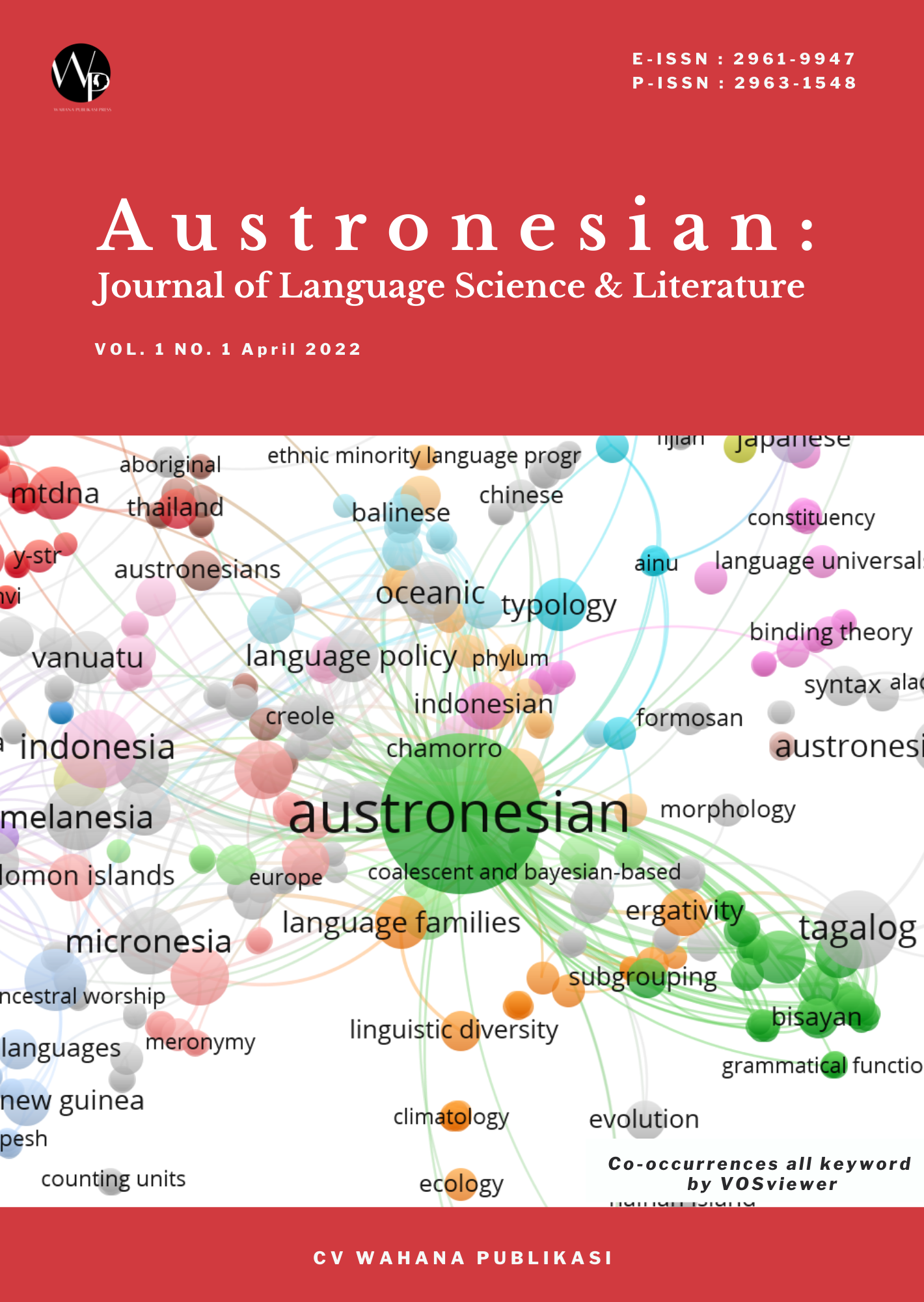Different Perspective of Understanding between Indonesian and Malaysian in Communication Style
DOI:
https://doi.org/10.59011/austronesian.1.1.2022.21-28Keywords:
Communication, Cultures, Indonesian and Malaysian, MisunderstandingAbstract
Since many people have different cultural groups or cultural values sometimes causes misunderstandings. The research used descriptive qualitative which to investigate the different perspectives of both cultures such as the problem of misunderstanding of communication, the difference in communication styles and also to investigate the contrasting perspective in oral or written communication. The respondents of the research are Indonesian and Malaysian who took on social media YouTube. In collecting the data, the researchers used the observation with a video on YouTube and used diary notes to write the essential data of the research. The results shown that even though Malaysia and Indonesia are neighboring countries and these two countries almost have similar cultures, there are some different perspectives of understanding, especially in communication. Two aspects of communication became the issues of these two countries such as verbal communication and non-verbal communication. The different perspectives of communication style which classified into two aspects, namely verbal communication and non-verbal communication. The different perspective of verbal communication style occurs by using the words used or intonation to communicate or transfer the meaning. Meanwhile, the different perspectives of verbal communication style can be seen in the mannerism such as gestures or mimicking of people.
References
Bakker-Pieper, A., & de Vries, R. E. (2013). The Incremental Validity of Communication Styles Over Personality Traits for Leader Outcomes. Human Performance, 26(1), 1–19. https://doi.org/10.1080/08959285.2012.736900
Bogdan, R. C., & Biklen, S. K. (2011). Qualitative Research for Education: An Introduction to Theories and Methods (5th ed.). Boston: Pearson.
Cazden, C. B. (2001). Classroom Discourse: The Language of Teaching and Learning (2nd ed.). Harvard: Heinemann.
Charley, H. D. (1991). Dynamics of Intercultural Communcaition. USA: Wm. C. Brown.
De Vries, R. E., Bakker-Pieper, A., Siberg, R. A., Van Gameren, K., & Vlug, M. (2009). The content and dimensionality of communication styles. Communication Research, 36(2), 178–206. https://doi.org/10.1177/0093650208330250
DuPraw, M. E., & Axner, M. (1997). Working on Common Cross-cultural Communication Challenges. Arcadia Picture, PBS Online. Retrieved from https://www.pbs.org/ampu/crosscult.html
Duta, N., Panisoara, G., & Panisoara, I.-O. (2015). The Effective Communication in Teaching. Diagnostic Study Regarding the Academic Learning Motivation to Students. Procedia - Social and Behavioral Sciences, 186(May), 1007–1012. https://doi.org/10.1016/j.sbspro.2015.04.064
Liliweri, A. (2009). Makna Budaya dalam Komunikasi antar Budaya. Yogyakarta: PT. LKiS Pelangi Aksara.
Loraine, S.-T. (2019). Communication Style and Learning Style of Students in Higher Education Institution. International Journal of Advanced Research in Management and Social Sciences, 8(6), 816–831. Retrieved from https://indianjournals.com/ijor.aspx?target=ijor:ijarmss&volume=8&issue=6&article=059
McKey, M., Davis, M., & Fanning, P. (2009). Messages: the Communication Skills Book (3rd ed.). Oakland: New Harbinger Publication, Inc.
Pânişoară, G., Sandu, C., Pânişoară, I.-O., & Duţă, N. (2015). Comparative Study Regarding Communication Styles of The Students. Procedia - Social and Behavioral Sciences, 186(May), 202–208. https://doi.org/10.1016/j.sbspro.2015.04.066
Samovar, L. A., Porter, R. E., & McDaniel, E. R. (2010). Komunikasi Lintas Budaya: Communication betwen Culture. Jakarta: Salemba Humanika.
Sdeeq, B. M. M., Sulaiman, E. F., Hamad, C. Z., & Abdullah, Z. D. (2021). Proper Communication Styles in Educational Setting from Lecturers’ Perspectives. International Journal for Educational and Vocational Studies, 3(1), 17–23. https://doi.org/10.29103/ijevs.v3i1.3855
Tanjung, F. (2019). Awareness of History Nation Serumpun (Indonesia-Malaysia): Culture without Borders. In M. R. S. Damanik, D. Setiawan, N. Berutu, E. L. Damanik, & R. Rahim (Eds.), 1st International Conference on Social Sciences and Interdisciplinary Studies (ICSSIS 2018) Awareness (Vol. 208, pp. 63–67). Meda: Atlantis Press. https://doi.org/10.2991/icssis-18.2019.13
Umami, R. (2022). Cross-Cultural Communication Problems between Indonesia adn Malaysia. Skylandsea Profesional: Jurnal Bisnis, Ekonomi Dan Teknologi, 2(1), 8–16. Retrieved from https://jurnal.yappsu.org/index.php/skylandsea/article/view/45
Yuniarti, N., Sastromiharjo, A., Sunendar, D., & Mulyati, Y. (2019). Intercultural Communication in Indonesia Language Education (Reflection of Attitude Language on Indonesian Language in the Trade Context by Indonesia-Malaysia Border Communities in West Kalimantan). In H. Nurdiyanto, B. R. Setiadi, & U. Nurwijayanto (Eds.), Proceedings of the 1st International Conference on Science and Technology for an Internet of Things (pp. 1–12). Yogyakarta: EAI. https://doi.org/10.4108/eai.19-10-2018.2282010
Downloads
Published
How to Cite
Issue
Section
License
Copyright (c) 2022 Harisa Dwi Oktira, Umar Mono, Alemina Br.Perangin-angin

This work is licensed under a Creative Commons Attribution-NonCommercial-ShareAlike 4.0 International License.






